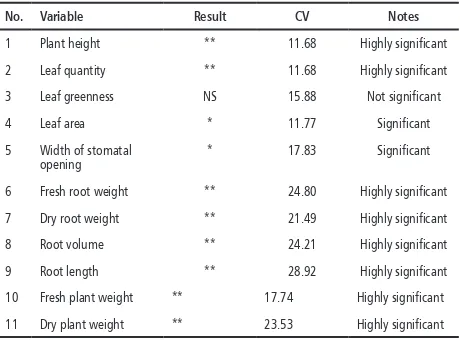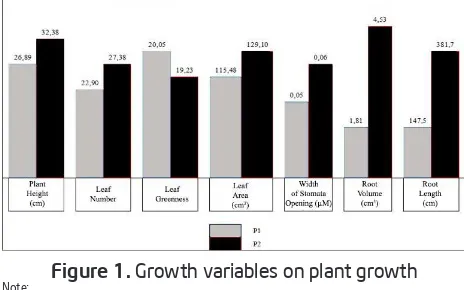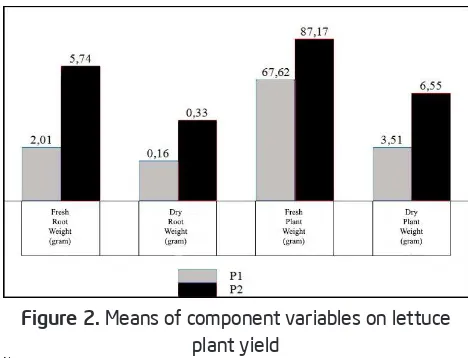INTRODUCTION
Lettuce (Lactuca sativa L.) is a group of leafy vegetables that are well known in the communi-ty. The prospect of market absorption on lettuce commodities will increase corresponding to the increase in population, the level of community education, income and welfare of society, and the public’s preference for lettuce (Samadi, 2014). Lettuce production fluctuates, but in Indonesia its production tends to decline in recent years, in 2013 its production was 635,728 and decreased to 602,468 tons in 2014 (Minis-try of Agriculture, 2015).
Currently, the efforts for increasing lettuce production mostly conducted by
intensifica-tion such as using excessive inorganic fertilizers and synthetic chemical pesticides, it makes farmers depend on fertilizers and pesticides. Intensive uses of inorganic fertilizers could not increase the productivity, and tended to reduce soil empowerment and health. According to Adiningsih (2005), the major key to improve soil health is increasing the content of soil organic materials, because of the low content of organic matter will reduce the nutrient carrying capacity and less efficient in using fertilizer because most of the nutrient components will disappear from the root environment. According to Sugito and Nuraini (2002), organic fertilizers are capable on
Growth and Yield of Lettuce (Lactuca sativa L.) Under Organic
Cultivation
DOI: 10.18196/pt.2017.073.127-131
Mujiono1*, Suyono2, and Purwanto1
1Agrotechnology Department, Faculty of Agriculture, Jenderal Soedirman University 2Agribusiness Departement, Faculty of Agriculture, Jenderal Soedirman University
Jl. Dr. Soeparno 61 Karangwangkal, Purwokerto Central Java Indonesia, 53123, *Corresponding author, email: mujiono_wd@yahoo.com
ABSTRACT
This research was conducted to understand the technology of organic lettuce cultivation using liquid organic fertilizer and pesticide on the production of lettuce. Study was arranged in completely randomized design (CRD) with two treatments and 16 replicates. The treatments were P1 (goat manure + 6 ml/l of SO Kontan LQ Liquid Organic Fertilizer for soil (LOF) + 6 ml/l of SO-Kontan Fert. LOF for leaf + 6% of maja-gadung botanical pesticide + 10 g/plant of biological agent Trichoderma harzianum) and P2 (goat manure + 6 ml/l of SO-Kontan LQ LOF + 6 ml/l of SO-Kontan Fert. LOF + 6% of maja-gadung botanical pesticide + bamboo leaves + 10 g/plant of biological agent T. harzianum. Results showed that the P2 was more effective than P1 for all variables of growth and yield, except the green colour of leaves. The preferable technology of LOF and botanical pesticide in organic lettuce cultivation was the P2 (goat manure + 6 ml/l of SO-Kontan LQ soil LOF Lq + 6 ml/l of SO-Kontan Fert. LOF + 6% of maja-gadung botanical pesticide + bamboo leaves + 10 g/plant of biological agent T. harzianum as indicating by productivity in 87.17 g per plant.
Keywords: Organic lettuce, Cultivation, Assembly, Liquid ogranic fertilizer (LOF), Botanical pesticide
ABSTRAK
Penelitian ini bertujuan untuk mengetahui teknologi budidaya selada organik berbasis pupuk organik cair dan pestisida nabati yang menghasilkan kom-ponen pertumbuhan tertinggi. Rancangan yang digunakan adalah Rancangan Acak Lengkap (RAL) dengan 2 perlakuan dan 16 ulangan. Perlakuan yang digunakan yaitu P1 (pupuk kendang kambing + POC tanah SO-kontan Lq (6 ml/l) + POC daun SO-Kontan Fert (6 ml/l) + Pestisida nabati maja gadung (6%) + agens hayati Trichoderma harzianum (10 g/polybag), dan P2 ( pupuk kendang kambing + POC tanah SO-kontan Lq (6 ml/l) + POC daun SO-Kontan Fert (6 ml/l) + Pestisida nabati maja gadung (6%) + agens hayati Trichoderma harzianum (10 g/plant) + daun bamboo). Hasil penelitian menunjukkan bahwa teknologi budidaya selada organik berbasis pupuk organik cair dan pestisida nabati yang terbaik adalah rakitan P2 (pupuk kandang (10 ton/ha) + POC tanah SO-kontan Lq (6 ml/l) + POC daun SO-Kontan Fert (6 ml/l) + Pestisida nabati maja gadung (6%) + agens hayati Trichoderma harzianum (10 g/polybag) + daun bambu) dengan produksi 32.36 g/tanaman.
increasing the absorption of N component up to 55% by increasing the yield until 10%.
The previous research has produced two best technology assemblies in cultivation of organic lettuce among seven tested cultivation technolo-gies, namely the assemblies containing compo-nents such 1) goat manure + SO Kontan Lq soil LOF (6 ml/l) + combined SO Kontan Fert leaf LOF (6 ml/l) + maja-gadung botanical pesticide (6%) + bamboo leaves + biological agent T.
har-zianum (10 g/plant) (Mujiono, 2015) and 2) goat
manure + SO-Kontan LQ soil LOF Lq (6 ml/l) + combined SO-Kontan Fert leaf LOF (6 ml/l) + maja-gadung botanical pesticide (6%) + bamboo leaves + biological agent Trichoderma harzianum (10 g/plant) (Mujiono, 2015).
Uses of bamboo leaves as a mixture material for planting medium has numerously carried out. These leaves have many benefits in agricul-ture. The result of phytochemical observations on the bamboo leaves shows that they contain 1.56% phenol, 29% fatty acid, 27.03% methyl ester, 12.13% linolenate, and 3.62% phytol (Ra-hayu et al., 2011). This research was conducted to understand selected technology assembly in the organic lettuce using LOF and botanical pesticide.
MATERIALS AND METHODS
The research was conducted from May to October 2016 at screen house in Windujaya Vil-lage, Kedungbanteng Sub District, Banyu. The research was conducted by using an experimen-tal method with Complete Randomized Design (CRD) containing two treatments and 16 rep-licates. The treatments were technology assem-blies of organic lettuce cultivation based on LOF and botanical pesticide. They were P1 (goat manure + SO-Kontan LQ soil Liquid Organic Fertilizer (LOF) (6 ml/l) + combined SO-Kontan
Fert leaf LOF (6 ml/l) + maja-gadung botanical pesticide (6%) + biological agent Trichoderma harzianum (10 g/plant) and P2 (goat manure + SO-Kontan LQ soil LOF Lq (6 ml/l) + combined SO-Kontan Fert leaf LOF (6 ml/l) + maja-gadung botanical pesticide (6%) + bamboo leaves + bio-logical agent Trichoderma harzianum (10 g/plant).
Variables observed were plant height, leaf numbers, leaf green level, leaf index, width of sto-matal opening, fresh root weight, dry root weight, root volume, and root length. Data obtained from the research were analyzed by using analy-ses of variances, the data of significantly differ-ent treatmdiffer-ents were further tested by Duncan’s multiple range test (Duncan Multiple).
RESULTS AND DISCUSSIONS
The results showed that almost all of growth and yield components performed by assembly of organic lettuce cultivation technology was highly significant on variables of plant height, leaf num-bers, fresh plant weight, dry plant weight, fresh root weight, dry root weight, root volume, and root length, whereas the treatments showed sig-nificantly different on the variables of leaf extent and width of the stomata opening, and insignifi-cantly different on the leaf green level (Table 1).
Table 1. The Growth and Yield of Lettuce
No. Variable Result CV Notes
1 Plant height ** 11.68 Highly significant 2 Leaf quantity ** 11.68 Highly significant 3 Leaf greenness NS 15.88 Not significant 4 Leaf area * 11.77 Significant 5 Width of stomatal
opening
* 17.83 Significant
6 Fresh root weight ** 24.80 Highly significant 7 Dry root weight ** 21.49 Highly significant 8 Root volume ** 24.21 Highly significant 9 Root length ** 28.92 Highly significant 10 Fresh plant weight ** 17.74 Highly significant 11 Dry plant weight ** 23.53 Highly significant
Growth Component Variables
The treatment of assembly in the organic lettuce cultivation technology influenced highly significant difference on all variables of organic lettuce plant growth, except the leaf greenness which the variable observations can be seen in Figure 1.
Figure 1. Growth variables on plant growth
Note:
P1= goat manure + 6 ml/l of SO Kontan LQ Liquid Organic Fertilizer for soil (LOF) + 6 ml/l of SO-Kontan Fert. LOF for leaf + 6% of maja-gadung botanical pesticide + 10 g/plant of biological agent Trichoderma harzianum
P2= goat manure + 6 ml/l of SO-Kontan LQ LOF + 6 ml/l of SO-Kontan Fert. LOF + 6% of maja-gadung botanical pesticide + bamboo leaves + 10 g/plant of bio logical agent T. harzianum
Plant height
This variable is observed as many as 12 times by three days interval and the results vary. The P2 assembly using bamboo leaf mulch performed better result when compared with P1 at the last observation (Figure 1). This may be due to that the content of bamboo leaves is capable to increase the lettuce plant height. Purwono and Purnamawati (2007) stated that bamboo leaves contained elements of P and K to form and to transport carbohydrate, as a catalysator in pro-tein formation and to regulate many mineral elements.
Leaf quantity
Based on Anova, the assembly treatment af-fects strongly to the leaf quantity variable. Leaf number means on the last observation show that the P2 assembly is 27.38 leaves greater than P1 having 22.90 leaves (Figure 1).
The difference between P1 and P2 is on the use of bamboo leaf mulch which causes the organic material sources on the P2 treatment are greater. The presence of the fungus T. harzia-num and SO-Kontan Lq LOF as catalisators for organic matter degradation enables potential of plant growth to rise. This is supported by Mu-jiono (2011) statement to explain that T. harzia-num gives roles in the process of organic matter decomposition, so the plants will absorb more numerous nutrition.
Leaf greenness
Result of Anova shows that the assembly treatment does not influence significantly to the leaf greenness (Table 1). This may be assumed due to magnesium element (Mg) functions as the central element to form chlorophyll has been available in the planting medium. The product quality of fresh lettuce preferred by consumers is when the leaf greenness showing not so high.
Width of stomatal opening
Width of stomatal opening on the P2 as-sembly is higher than the P1 one. This may be presumed that there was an increasing tempera-ture at the P2 assembly. Planting medium at the P1 assembly which did not use bamboo leaves tended to give blacker in color when compared with the P2 assembly, so it caused higher temper-ature at the P2 assembly. Bamboo leaves tended to absorb and to keep heat from surroundings, resulting in narrower width of stomatal opening for suppressing transpiration and dehydration. This is powered by Haryanti (2010) stated that stomatal width was closely related to the plant transpiration level to adapt with the environ-ment.
Leaf area
af-fects significantly on the leaf area variable (Table 1). The measurement on it performs that the P2 treatment gives better result than P1 as seen in Figure 1. Leaf area is closely concerned with the ability of plants to grow and develop in their life cycle particularly on the phase of root initia-tion. This result is strengthen by Purwono and Purnamawati (2007) stating that bamboo leaves contain many P element. P element in the phos-phate ion is very useful for plants to stimulate root growth especially in initial growth.
Root length
Root length is measured by measuring all plant roots, also root quantity in a plant. Based on the Anova, the assembly treatments influence strongly on the root length (Table 1). The P2 as-sembly performs longer root length than the p1 assembly (Figure 1). This may be assumed that root growth and development are determined by the type of medium used. The P2 used bam-boo leaves having hygroscopic trait to make the increase of soil porosity, resulting in root devel-opment.
Root volume
The root volume variable is determined by root length and root ability to absorb water in the planting medium. Root volume linearly relates to root length. The anova shows that the assembly treatments perform highly significant influence on root volume (Table 1). Planting medium at the P2 assembly used bamboo leaf mulch produced high hygroscopic level and wa-ter absorption. The condition causes the plants easily absorb water from the planting medium and oxygen is sufficient, so this will support sec-ondary root development. Measurement of root volume at the P2 assembly is better than the P1 assembly (Figure 1).
Yield components
Yield variables comprise plant fresh and dry weights, fresh and dry root weights perform simi-lar yield with growth variables. Figure 2 shows yield variables.
Figure 2. Means of component variables on lettuce plant yield
Note:
P1= goat manure + 6 ml/l of SO Kontan LQ Liquid Organic Fertilizer for soil (LOF) + 6 ml/l of SO-Kontan Fert. LOF for leaf + 6% of maja-gadung botanical pesticide + 10 g/plant of biological agent Trichoderma harzianum
P2= goat manure + 6 ml/l of SO-Kontan LQ LOF + 6 ml/l of SO-Kontan Fert. LOF + 6% of maja-gadung botanical pesticide + bamboo leaves + 10 g/plant of bio logical agent T. harzianum
Fresh root weight
The Anova shows that the assembly treat-ments strongly affect on the fresh root weight (Table 1). The highest root weight was found on the P2 assembly treatment (Figure 2). This may be due to high porosity on the planting medium using bamboo leaf mulch causing better growth and development of the roots when compared with root growth and development in the P1 assembly. Better growth and development of the roots lead to increasing root number and weight.
Dry root weight
espe-cially water and carbohydrate depending on the photosynthesis rate of the plant (Lakitan, 1996). The P2 assembly contains bamboo leaves leading to much P element. According to Leiwakabessy
et al., (2003), P element was important in
genera-tive growth plant root development.
Yield (weight of fresh or proper harvest plants)
Based on the Anova, the assembly treatments affect strongly to the yield or fresh plant weight. This implies that the treatments influence very significantly to the yield (Table 1). The high-est yield (fresh plant weight or proper harvhigh-est weight) is found at the P2 assembly treatment, reaching 87.17 g/plant, whereas the P1 assembly only reaching 67.62 g/plant (Figure 2). Plant growth and development is closely related to the yield. Lettuce is a plant possessing economic value on its leaves as the vegetative component. Good growth gained at the P2 assembly will also determine lettuce plant yield variables, particu-larly on fresh plant weight.
Dry plant weight
The Anova performs that the assembly treat-ments significantly influence on dry plant weight (Table 1). Dry plant weight will be linearly relat-ed to fresh plant weight. The dry plant weight on the p2 assembly is greater than the P1 assembly (Figure 2). This can be caused the presence of bamboo leaves in the P2 assembly is capable to increase plant growth and development and also increase the net assimilation on the plant.
CONCLUSION
The research can be concluded preferable technology of LOF and botanical pesticide in or-ganic lettuce cultivation was the P2 (goat manure + 6 ml/l of SO-Kontan LQ soil LOF Lq + 6 ml/l of SO-Kontan Fert. LOF + 6% of maja-gadung
botanical pesticide + bamboo leaves + 10 g/plant of biological agent T. harzianum as indicating by productivity in 87.17 g per plant.
REFERENCES
Haryanti, S. 2010. Pengaruh naungan yang berbeda terhadap jumlah stomata dan ukuran porus stomata daun
Zephy-ranthes Rosea lindl. Buletin Anatomi dan iologi. 18 (1): 41-48.
Kementerian Pertanian. 2015. Data Produksi Hortikultura. Ac-cessed on 28 Agustus 2016. https://aplikasi.pertanian. go.id/bdsp/hasil_kom.asp.
Lakitan, B. 1996. Fisiologi Pertumbuhan dan Perkembangan
Tanaman. PT. Raja Graindo Persada, Jakarta.
Leiwakabessy M., U.M. Wahjudin, Suwarno. 2003. Kesuburan
Tanah. IPB Press, Bogor.
Mujiono, Suyono, dan Purwanto. 2015. Perakitan Teknologi Budidaya Selada Organik Berbasis Pupuk Organik Cair dan Pestisida Nabati. Seminar Nasional Dies Natalis UGM. Yogyakarta, 19 September 2015. 15 p.
_______, Suyono, Purwanto dan Tarjoko, 2011. Perakitan teknologi produksi padi organik berbasis pupuk organik cair dan pestisida nabati. Agroland 18 (3):162-168. Purwono dan Purnamawati. 2007. Budidaya 8 jenis tanaman
pangan unggul. Penebar Swadaya, Jakarta. 14p.
Rahayu, M. Bata dan A. Marsudi. 2011. Potensi Ekstrak Daun Bambu Sebagai Antibakteri Dalam Susu Pedet PfhLepas
Kolostrum.Balitbang pertanian. 34 p.
Samadi, B. 2014. Rahasia Budidaya Selada. Pustaka Mina,
Jakarta. 110 p.
Sugito, Y.dan Y. Nuraini. 2002. Sistem Pertqanian Organik.
Dalam Soecipto, M.C. Mahfud dan M. Ali Yusron (Eds.).


